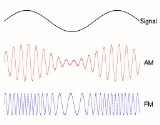
Amplitude modulation
Overview
Radio
Radio is the transmission of signals through free space by modulation of electromagnetic waves with frequencies below those of visible light. Electromagnetic radiation travels by means of oscillating electromagnetic fields that pass through the air and the vacuum of space...
carrier wave
Carrier wave
In telecommunications, a carrier wave or carrier is a waveform that is modulated with an input signal for the purpose of conveying information. This carrier wave is usually a much higher frequency than the input signal...
. AM works by varying the strength of the transmitted signal in relation to the information being sent. For example, changes in signal strength may be used to specify the sounds to be reproduced by a loudspeaker
Loudspeaker
A loudspeaker is an electroacoustic transducer that produces sound in response to an electrical audio signal input. Non-electrical loudspeakers were developed as accessories to telephone systems, but electronic amplification by vacuum tube made loudspeakers more generally useful...
, or the light intensity of television pixels. Contrast this with frequency modulation
Frequency modulation
In telecommunications and signal processing, frequency modulation conveys information over a carrier wave by varying its instantaneous frequency. This contrasts with amplitude modulation, in which the amplitude of the carrier is varied while its frequency remains constant...
, in which the frequency
Frequency
Frequency is the number of occurrences of a repeating event per unit time. It is also referred to as temporal frequency.The period is the duration of one cycle in a repeating event, so the period is the reciprocal of the frequency...
is varied, and phase modulation
Phase modulation
Phase modulation is a form of modulation that represents information as variations in the instantaneous phase of a carrier wave.Unlike its more popular counterpart, frequency modulation , PM is not very widely used for radio transmissions...
, in which the phase
Phase (waves)
Phase in waves is the fraction of a wave cycle which has elapsed relative to an arbitrary point.-Formula:The phase of an oscillation or wave refers to a sinusoidal function such as the following:...
is varied.
In the mid-1870s, a form of amplitude modulation—initially called "undulatory currents"—was the first method to successfully produce quality audio over telephone lines.
Unanswered Questions

